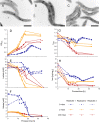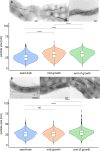An automated oxystat fermentation regime for microoxic cultivation of Magnetospirillum gryphiswaldense
- PMID: 33168043
- PMCID: PMC7654035
- DOI: 10.1186/s12934-020-01469-z
An automated oxystat fermentation regime for microoxic cultivation of Magnetospirillum gryphiswaldense
Abstract
Background: Magnetosomes produced by magnetotactic bacteria represent magnetic nanoparticles with unprecedented characteristics. However, their use in many biotechnological applications has so far been hampered by their challenging bioproduction at larger scales.
Results: Here, we developed an oxystat batch fermentation regime for microoxic cultivation of Magnetospirillum gryphiswaldense in a 3 L bioreactor. An automated cascade regulation enabled highly reproducible growth over a wide range of precisely controlled oxygen concentrations (1-95% of air saturation). In addition, consumption of lactate as the carbon source and nitrate as alternative electron acceptor were monitored during cultivation. While nitrate became growth limiting during anaerobic growth, lactate was the growth limiting factor during microoxic cultivation. Analysis of microoxic magnetosome biomineralization by cellular iron content, magnetic response, transmission electron microscopy and small-angle X-ray scattering revealed magnetosomal magnetite crystals were highly uniform in size and shape.
Conclusion: The fermentation regime established in this study facilitates stable oxygen control during culturing of Magnetospirillum gryphiswaldense. Further scale-up seems feasible by combining the stable oxygen control with feeding strategies employed in previous studies. Results of this study will facilitate the highly reproducible laboratory-scale bioproduction of magnetosomes for a diverse range of future applications in the fields of biotechnology and biomedicine.
Keywords: Magnetosome biomineralization; Magnetosomes; Magnetospirillum gryphiswaldense; Oxystat fermentation.
Conflict of interest statement
The authors declare that they have no competing interests.
Figures





Similar articles
-
The transcriptomic landscape of Magnetospirillum gryphiswaldense during magnetosome biomineralization.BMC Genomics. 2022 Oct 10;23(1):699. doi: 10.1186/s12864-022-08913-x. BMC Genomics. 2022. PMID: 36217140 Free PMC article.
-
Large-scale production of magnetosomes by chemostat culture of Magnetospirillum gryphiswaldense at high cell density.Microb Cell Fact. 2010 Dec 12;9:99. doi: 10.1186/1475-2859-9-99. Microb Cell Fact. 2010. PMID: 21144001 Free PMC article.
-
Probing the Nanostructure and Arrangement of Bacterial Magnetosomes by Small-Angle X-Ray Scattering.Appl Environ Microbiol. 2019 Nov 27;85(24):e01513-19. doi: 10.1128/AEM.01513-19. Print 2019 Dec 15. Appl Environ Microbiol. 2019. PMID: 31604767 Free PMC article.
-
Magnetosome biogenesis in magnetotactic bacteria.Nat Rev Microbiol. 2016 Sep 13;14(10):621-37. doi: 10.1038/nrmicro.2016.99. Nat Rev Microbiol. 2016. PMID: 27620945 Review.
-
Bacterial magnetosome and its potential application.Microbiol Res. 2017 Oct;203:19-28. doi: 10.1016/j.micres.2017.06.005. Epub 2017 Jun 20. Microbiol Res. 2017. PMID: 28754204 Review.
Cited by
-
Set-up of a pharmaceutical cell bank of Magnetospirillum gryphiswaldense MSR1 magnetotactic bacteria producing highly pure magnetosomes.Microb Cell Fact. 2024 Feb 28;23(1):70. doi: 10.1186/s12934-024-02313-4. Microb Cell Fact. 2024. PMID: 38419080 Free PMC article.
-
Towards a 'chassis' for bacterial magnetosome biosynthesis: genome streamlining of Magnetospirillum gryphiswaldense by multiple deletions.Microb Cell Fact. 2021 Feb 4;20(1):35. doi: 10.1186/s12934-021-01517-2. Microb Cell Fact. 2021. PMID: 33541381 Free PMC article.
-
Azide click chemistry on magnetotactic bacteria: A versatile technique to attach a cargo.Mater Today Bio. 2023 Feb 23;19:100587. doi: 10.1016/j.mtbio.2023.100587. eCollection 2023 Apr. Mater Today Bio. 2023. PMID: 36910269 Free PMC article.
-
The transcriptomic landscape of Magnetospirillum gryphiswaldense during magnetosome biomineralization.BMC Genomics. 2022 Oct 10;23(1):699. doi: 10.1186/s12864-022-08913-x. BMC Genomics. 2022. PMID: 36217140 Free PMC article.
-
An Integrated Approach to Elucidate the Interplay between Iron Uptake Dynamics and Magnetosome Formation at the Single-Cell Level in Magnetospirillum gryphiswaldense.ACS Appl Mater Interfaces. 2024 Nov 13;16(45):62557-62570. doi: 10.1021/acsami.4c15975. Epub 2024 Oct 31. ACS Appl Mater Interfaces. 2024. PMID: 39480433 Free PMC article.
References
-
- Lohße A, Ullrich S, Katzmann E, Borg S, Wanner G, Richter M, Voigt B, Schweder T, Schüler D. Functional analysis of the magnetosome island in Magnetospirillum gryphiswaldense: the mamAB operon is sufficient for magnetite biomineralization. PLoS ONE. 2011;6:e25561. doi: 10.1371/journal.pone.0025561. - DOI - PMC - PubMed
-
- Lohße A, Borg S, Raschdorf O, Kolinko I, Tompa É, Pósfai M, Faivre D, Baumgartner J, Schüler D. Genetic dissection of the mamAB and mms6 operons reveals a gene set essential for magnetosome biogenesis in Magnetospirillum gryphiswaldense. J Bacteriol. 2014;196:2658–2669. doi: 10.1128/JB.01716-14. - DOI - PMC - PubMed
MeSH terms
Substances
Supplementary concepts
Grants and funding
LinkOut - more resources
Full Text Sources
Molecular Biology Databases

